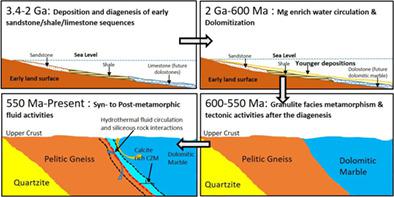当前位置:
X-MOL 学术
›
Geolog. J.
›
论文详情
Our official English website, www.x-mol.net, welcomes your feedback! (Note: you will need to create a separate account there.)
Mineralogical and geochemical constraints on the provenance and depositional setting of Sri Lankan marbles
Geological Journal ( IF 1.8 ) Pub Date : 2021-06-09 , DOI: 10.1002/gj.4169 Nadeesha Srimali Madugalla 1 , Amarasooriya Pitawala 2
Geological Journal ( IF 1.8 ) Pub Date : 2021-06-09 , DOI: 10.1002/gj.4169 Nadeesha Srimali Madugalla 1 , Amarasooriya Pitawala 2
Affiliation

|
Proterozoic high-grade marbles cover a significant portion of the Highland Complex (HC) of Sri Lanka. Although many studies on metamorphic silicate rocks of the country have been carried out, marbles, which can be used as a tool to interpret the evolution history of the crust, has been paid little attention. The present study aims to understand the genesis and characteristics of protolith of these marbles by investigating their mineralogy and geochemistry. The studied marbles occur as bands intercalated with pelitic gneisses and quartzites of the HC, indicating the pre-existing sandstone-shale-carbonate sedimentary sequence. Except along the lithological contacts, the studied marbles contain low amounts of silicate minerals (<5%) and are dominated by dolomites (>90%) with minor calcites. Calcites occur as inclusions within dolomites or as fine grains along the grain boundaries of dolomites. Silicate minerals always occur as lensoid or layered aggregations. Dolomites are related to the protolith composition, while most of the calcites are metamorphic products formed due to the reaction of silicate minerals with dolomite. Silicate mineralogical zones suggest the inherited compositional variations of the protolith. Although the marbles have undergone granulite-grade metamorphism, their trace elemental contents have been well preserved. Concentrations of Fe, Mn, Sr, Na, and K as well as rare earth element (REE) contents of the marbles are comparable to those of marine origin carbonates. Hence, marine dolostone can be proposed as the protolith for Sri Lankan marbles. The distinct mineralogy as well as elevated trace element and REE concentrations of marble in the lithological contact zones are evidenced for prevailed syn- to post-metamorphic fluid activities in the HC. Mineralogical and trace elemental composition of Sri Lankan marbles are correlated well with the marbles from other East-Gondwanaland crustal units.
中文翻译:

斯里兰卡大理石物源和沉积环境的矿物学和地球化学限制
元古代高级大理石覆盖了斯里兰卡高地复合体 (HC) 的很大一部分。虽然国内对变质硅酸盐岩进行了大量研究,但可作为解释地壳演化历史的工具的大理岩却鲜有关注。本研究旨在通过研究这些大理岩的矿物学和地球化学,了解这些大理岩原岩的成因和特征。所研究的大理岩以带夹杂着 HC 的泥质片麻岩和石英岩的形式出现,表明先前存在的砂岩-页岩-碳酸盐沉积序列。除了沿岩性接触,所研究的大理岩含有少量的硅酸盐矿物(<5%),以白云岩(>90%)为主,含有少量方解石。方解石以白云岩内的包裹体或沿白云岩晶界的细粒形式出现。硅酸盐矿物总是以透镜状或层状聚集体的形式出现。白云岩与原岩成分有关,而大部分方解石是硅酸盐矿物与白云石反应形成的变质产物。硅酸盐矿物学带表明原岩的遗传成分变化。虽然这些大理石经历了麻粒岩级变质作用,但其微量元素含量得到了很好的保存。大理石的 Fe、Mn、Sr、Na 和 K 的浓度以及稀土元素 (REE) 含量与海洋碳酸盐的含量相当。因此,可以提出海相白云岩作为斯里兰卡大理石的原岩。岩性接触带中大理岩的独特矿物学以及微量元素和稀土元素浓度升高,证明了 HC 中盛行的同变质到变质后流体活动。斯里兰卡大理岩的矿物学和微量元素组成与来自其他东冈瓦纳大陆地壳单元的大理岩具有很好的相关性。
更新日期:2021-06-09
中文翻译:

斯里兰卡大理石物源和沉积环境的矿物学和地球化学限制
元古代高级大理石覆盖了斯里兰卡高地复合体 (HC) 的很大一部分。虽然国内对变质硅酸盐岩进行了大量研究,但可作为解释地壳演化历史的工具的大理岩却鲜有关注。本研究旨在通过研究这些大理岩的矿物学和地球化学,了解这些大理岩原岩的成因和特征。所研究的大理岩以带夹杂着 HC 的泥质片麻岩和石英岩的形式出现,表明先前存在的砂岩-页岩-碳酸盐沉积序列。除了沿岩性接触,所研究的大理岩含有少量的硅酸盐矿物(<5%),以白云岩(>90%)为主,含有少量方解石。方解石以白云岩内的包裹体或沿白云岩晶界的细粒形式出现。硅酸盐矿物总是以透镜状或层状聚集体的形式出现。白云岩与原岩成分有关,而大部分方解石是硅酸盐矿物与白云石反应形成的变质产物。硅酸盐矿物学带表明原岩的遗传成分变化。虽然这些大理石经历了麻粒岩级变质作用,但其微量元素含量得到了很好的保存。大理石的 Fe、Mn、Sr、Na 和 K 的浓度以及稀土元素 (REE) 含量与海洋碳酸盐的含量相当。因此,可以提出海相白云岩作为斯里兰卡大理石的原岩。岩性接触带中大理岩的独特矿物学以及微量元素和稀土元素浓度升高,证明了 HC 中盛行的同变质到变质后流体活动。斯里兰卡大理岩的矿物学和微量元素组成与来自其他东冈瓦纳大陆地壳单元的大理岩具有很好的相关性。



























 京公网安备 11010802027423号
京公网安备 11010802027423号